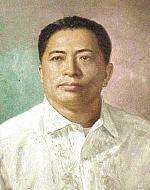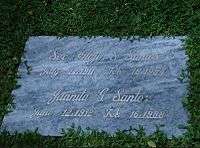Alejo Santos
| Alejo Santos | |
|---|---|
 | |
| Secretary of National Defense of the Philippines | |
|
In office June 11, 1959 – December 30, 1961 | |
| President | Carlos P. Garcia |
| Preceded by | Macario Peralta, Jr. |
| Succeeded by | Jesus M. Vargas |
| Governor of Bulacan | |
|
In office 1951–1957 | |
| Preceded by | Fortunato Halili |
| Succeeded by | Tomas Martin |
| Member of the House of Representatives from Bulacan's Second District | |
|
In office 1946–1946 | |
| Preceded by | Antonio Villarama |
| Succeeded by | Vacant[1] |
|
In office December 30, 1949 – December 30, 1951 | |
| Preceded by | Vacant |
| Succeeded by | Rogaciano M. Mercado |
| Personal details | |
| Born |
Alejo de los Santos de los Santos July 17, 1911Note 1 Bustos, Bulacan, Philippine Islands |
| Died |
February 18, 1984 (aged 72) Quezon City, Philippines |
| Political party |
Nacionalista Party (1949-1984) Democratic Alliance (1946-1949) |
| Military service | |
| Allegiance |
|
| Service/branch |
United States Army Forces Far East Philippine Commonwealth Army |
| Rank |
|
| Commands | Bulacan Military Area |
| Battles/wars |
World War II *Battle of Bataan *Liberation of the Philippines |
Alejo Santos Santos (born Alejo de los Santos de los Santos; July 17, 1911Note 1 – February 18, 1984) was a Filipino soldier and World War II hero who parlayed his fame into a political career. His prestige was somewhat marred in later life when he agreed to run as the only major candidate opposing Ferdinand Marcos in the widely suspect 1981 Philippine presidential election.
Early life and guerrilla hero
Santos was born in Brgy. Bonga Menor, Bustos, Bulacan, to farmer Pedro de los Santos y de la Cruz and Regina de los Santos y Francisco.[2] He graduated from the University of Manila with an education degree.[3] He first served as Prison Guard with the Bureau of Prisons from 1933 to 1934. Santos married Juanita Garcia in 1934 and they had eight children: Reynaldo, Edgardo, Ravenal, Lamberto, Alexis, Liberty, Daisy, and Nenita.[4] At the outbreak of World War II, he was a captain of the USAFFE. He was among the USAFFE soldiers who retreated to Bataan to make the last stand against the invading Imperial Japanese Army. However, he evaded capture by the Japanese when Bataan fell, escaping instead to his hometown. Santos then agreed to join the fledgling anti-Japanese guerrilla warfare movement under Bernard L. Anderson.[5]:26 He became one of the founders of the Bulacan Military Area, the main guerrilla movement in Bulacan which had 23,000 men under its command. The BMA attracted many patriotic Filipinos chafing under Japanese rule, and was soon organized into eight divisions. For his World War II activities, Santos received numerous citations and awards from the Philippine and American governments. He was the only Filipino conferred the rank of brigadier general by the American government.
Political career
After the liberation of Bulacan by joint Filipino and American ground troops in 1945, Santos was named as its military governor. He was elected as to the House of Representatives in 1946, representing the 2nd District of Bulacan under the banner of the leftist Democratic Alliance, but was almost immediately unseated together with several of his party-mates in a controversial maneuver believed to be related with the looming congressional vote on the approval of the Bell Trade Act with the United States. Nonetheless, Santos was again elected to the House in 1949, and he served in the 2nd Congress until his election as governor of Bulacan in 1951. By then, Santos had affiliated with the Nacionalista Party. Santos would serve as governor until 1957, wherein 705 public works projects were constructed in Bulacan and the national government released Php 1.9 Million for these. From 1959 to 1961, Santos served as Secretary of National Defense in the cabinet of President Carlos P. Garcia. In 1967 he was appointed by President Marcos to head the prison bureau, a post he held until 1971.
Candidate against Marcos
By 1981, Santos had mostly retired from political life, devoting his activity to veterans affairs; thus, it came as a surprise when he agreed to run for President against Ferdinand Marcos in the 1981 elections. The elections were called shortly after Marcos lifted the nine-year-old declaration of martial law while retaining authoritarian powers at the same time, and were seen as a means of maintaining the veneer of democracy, especially in the international community. However, the anti-Marcos political opposition, which felt it was cheated out of victory in the 1978 parliamentary elections, refused to participate in the presidential elections and successfully called for a boycott. Santos' candidacy, ostensibly under the banner of the then-moribund Nacionalista Party, provided Marcos with at least one other "major" candidate he could run against. Santos, though the sole widely known opponent of Marcos, did not offer a vigorous campaign, and he was trounced in the election, garnering only 8% of the vote as against Marcos's 88%.

Santos died just three years later and was buried at the Libingan ng mga Bayani. A camp of the Philippine National Police in Bulacan is named after Santos.
Notes
- 1.^ ^ Alejo Santos was thirty-five days old when he was baptized on August 20, 1911, making July 16, 1911 as his date of birth.[2]
References
- ↑ Santos was unseated together with several of his party-mates in the leftist Democratic Alliance in a controversial maneuver believed to be related with the looming congressional vote on the approval of the Bell Trade Act with the United States.
- 1 2 "Film # 007773259 Image Film # 007773259 ; ark:/61903/3:1:3Q9M-CSMN-LQTS — FamilySearch.org". Retrieved May 11, 2016.
- ↑
- ↑ "Alejo S. Santos : CV". Dnd.gov.ph. Archived from the original on 2012-05-19. Retrieved 2013-10-13.
- ↑ Lapham, R., and Norling, B., 1996, Lapham's Raiders, Lexington: The University Press of Kentucky, ISBN 0813119499
Bibliography
Filipinos in History: Volume IV, National Historical Institute (Manila, 1994)
| Wikimedia Commons has media related to Alejo Santos. |
| Government offices | ||
|---|---|---|
| Preceded by Fortunato Halili |
Governor of Bulacan 1951–1957 |
Succeeded by Tomas Martin |
| Political offices | ||
| Preceded by Macario Peralta, Jr. |
Philippine Secretary of National Defense 1959–1961 |
Succeeded by Jesus M. Vargas |